Evaluation of the Processing of Multi-Crop Plants into Pelletized Biofuel and Its Use for Energy Conversion
Abstract
1. Introduction
2. Materials and Methods
3. Results and Discussion
3.1. Qualitative Parameters of Produced Pellets
3.2. Determination of Harmful Emissions
4. Conclusions
Author Contributions
Funding
Institutional Review Board Statement
Informed Consent Statement
Data Availability Statement
Conflicts of Interest
References
- Martín-Gamboa, M.; Marques, P.; Freire, F.; Luís, A.; Dias, A.C. Life cycle assessment of biomass pellets: A review of methodological choices and results. Renew. Sustain. Energy Rev. 2020, 133, 110278. [Google Scholar] [CrossRef]
- Picchio, R.; Latterini, F.; Venanzi, R.; Stefanoni, W.; Suardi, A.; Tocci, D.; Pari, L. Pellet Production from Woody and Non-Woody Feedstocks: A Review on Biomass Quality Evaluation. Energies 2020, 13, 2937. [Google Scholar] [CrossRef]
- Wasilewski, J.; Zając, G.; Szyszlak-Bargłowicz, J.; Kuranc, A. Evaluation of Greenhouse Gas Emission Levels during the Combustion of Selected Types of Agricultural Biomass. Energies 2022, 15, 7335. [Google Scholar] [CrossRef]
- Qin, Z.; Zhuang, Q.; Cai, X.; He, Y.; Huang, Y.; Jiang, D.; Lin, E.; Liu, Y.; Tang, Y.; Wang, M.Q. Biomass and biofuels in China: Toward bioenergy resource potentials and their impacts on the environment. Renew. Sustain. Energy Rev. 2018, 82, 2387–2400. [Google Scholar] [CrossRef]
- König, M.; Eisinger, K.; Hartmann, I.; Müller, M. Combined removal of particulate matter and nitrogen oxides from the exhaust gas of small-scale biomass combustion. Biomass Convers. Biorefinery 2019, 9, 201–212. [Google Scholar] [CrossRef]
- Adeleke, A.A.; Odusote, J.K.; Ikubanni, P.P.; Lasode, O.A.; Malathi, M.; Paswan, D. Essential basics on biomass torrefaction, densification and utilization. Int. J. Energy Res. 2020, 45, 1375–1395. [Google Scholar] [CrossRef]
- Sarker, T.R.; Nanda, S.; Meda, V.; Dalai, A.K. Densification of waste biomass for manufacturing solid biofuel pellets: A review. Environ. Chem. Lett. 2022, 1–34. [Google Scholar] [CrossRef]
- Pradhan, P.; Mahajani, S.M.; Arora, A. Production and utilization of fuel pellets from biomass: A review. Fuel Process. Technol. 2018, 181, 215–232. [Google Scholar] [CrossRef]
- Konrád, K.; Viharos, Z.J.; Németh, G. Evaluation, ranking and positioning of measurement methods for pellet production. Measurement 2018, 124, 568–574. [Google Scholar] [CrossRef]
- Malaťák, J.; Velebil, J.; Bradna, J.; Gendek, A.; Tamelová, B. Evaluation of CO and NOx emissions in real-life operating conditions of herbaceous biomass briquettes combustion. Acta Technol. Agric. 2020, 23, 53–59. [Google Scholar] [CrossRef]
- Gu, C.; Bastiaans, L.; Anten, N.P.R.; Makowski, D.; van der Werf, W. Annual intercropping suppresses weeds: A meta-analysis. Agric. Ecosyst. Environ. 2021, 322, 107658. [Google Scholar] [CrossRef]
- Vlahova, V. Intercropping—An opportunity for sustainable farming systems. A review. Sci. Pap. Ser. A Agron. 2022, 65, 728–740. [Google Scholar]
- Raseduzzaman, M.; Jensen, E.S. Does intercropping enhance yield stability in arable crop production? A meta-analysis. Eur. J. Agron. 2017, 91, 25–33. [Google Scholar] [CrossRef]
- Gutierrez-Antonio, C.; Hernández-Neri, N.; Gutiérrez-Antonio, C.; García-Trejo, J.F.; Feregrino-Pérez, A.A.; Toledano-Ayala, M. Valorisation of rice husks and bean straws through fuel pellets production: An experimental and modelling approach. Revista Mexicana de Ingeniería Química 2022, 21, 22679. [Google Scholar]
- Parvez, A.M.; Lewis, J.D.; Afzal, M.T. Potential of industrial hemp (Cannabis sativa L.) for bioenergy production in Canada: Status, challenges and outlook. Renew. Sustain. Energy Rev. 2021, 141, 110784. [Google Scholar] [CrossRef]
- Kraszkiewicz, A.; Kachel, M.; Parafiniuk, S.; Zając, G.; Niedziółka, I.; Sprawka, M. Assessment of the Possibility of Using Hemp Biomass (Cannabis Sativa L.) for Energy Purposes: A Case Study. Appl. Sci. 2019, 9, 4437. [Google Scholar] [CrossRef]
- Prade, T.; Finell, M.; Svensson, S.E.; Mattsson, J.E. Effect of harvest date on combustion related fuel properties of industrial hemp (Cannabis sativa L.). Fuel 2012, 102, 592–604. [Google Scholar] [CrossRef]
- Miedaner, T.; Juroszek, P. Global warming and increasing maize cultivation demand comprehensive efforts in disease and insect resistance breeding in north-western Europe. Plant Pathol. 2021, 70, 1032–1046. [Google Scholar] [CrossRef]
- Gómez, L.D.; Amalfitano, C.; Andolfi, A.; Simister, R.; Somma, S.; Ercolano, M.R.; Borrelli, C.; McQueen-Mason, S.J.; Frusciante, L.; Cuciniello, A.; et al. Valorising faba bean residual biomass: Effect of farming system and planting time on the potential for biofuel production. Biomass Bioenergy 2017, 107, 227–232. [Google Scholar] [CrossRef]
- Romaneckas, K.; Balandaitė, J.; Sinkevičienė, A.; Kimbirauskienė, R.; Jasinskas, A.; Ginelevičius, U.; Romaneckas, A.; Petlickaitė, R. Short-Term Impact of Multi-Cropping on Some Soil Physical Properties and Respiration. Agronomy 2022, 12, 141. [Google Scholar] [CrossRef]
- ISO 18847:2016; Solid Biofuels—Determination of Particle Density of Pellets and Briquettes. Available online: https://www.iso.org/standard/63560.html (accessed on 7 November 2022).
- LST EN ISO 18134-1:2016; Determination of Moisture Content—Oven Dry Method—Part 1: Total Moisture-Reference Method. Lithuanian Standards Board: Vilnius, Lithuania, 2016.
- LST EN ISO 18122:2016; Solid Biofuels—Determination of Ash Content. Lithuanian Standards Board: Vilnius, Lithuania, 2016.
- LST EN ISO 16994:2016; Solid Biofuels—Determination of Total Content of Sulfur and Chlorine. Lithuanian Standards Board: Vilnius, Lithuania, 2016.
- LST EN ISO 16948:2015; Solid Biofuels—Determination of Total Content of Carbon, Hydrogen and Nitrogen. Lithuanian Standards Board: Vilnius, Lithuania, 2015.
- LST EN ISO 16967:2015; Solid Biofuels—Determination of Major Elements—Al, Ca, Fe, Mg, P, K, Si, Na and Ti. Lithuanian Standards Board: Vilnius, Lithuania, 2015.
- LST EN ISO 16968:2015; Solid Biofuels—Determination of Minor Elements. Lithuanian Standards Board: Vilnius, Lithuania, 2015.
- LST EN ISO 18125:2017; Solid Biofuels—Determination of Calorific Value. Lithuanian Standards Board: Vilnius, Lithuania, 2017.
- ISO 21404:2022; Solid Biofuels—Determination of Ash Melting Behavior (first edition 2022–01). Lithuanian Standards Board: Vilnius, Lithuania, 2022.
- Čepauskienė, D.; Vaškevičienė, I.; Praspaliauskas, M.; Pedišius, N. Comparison of the influence of additives on the melting behaviour of wheat straw and fibre hemp ash. Biomass Conv. Bioref. 2022. [Google Scholar] [CrossRef]
- LST EN 14785:2006; Residential Space Heating Appliances Fired by Wood Pellets—Requirements and Test Methods. Lithuanian Standards Board: Vilnius, Lithuania, 2006.
- LST CEN/TS 15883:2009; Residential Solid Fuel Burning Appliances—Emission Test Methods. Lithuanian Standards Board: Vilnius, Lithuania, 2009.
- Raudonius, S.; Jodaugienė, D.; Pupalienė, R.; Trečiokas, K. Research Methodology; Lithuanian University of Agriculture: Kaunas, Lithuanian, 2009; 34p. (In Lithuanian) [Google Scholar]
- Trejo-Zamudio, D.; Gutiérrez-Antonio, C.; García-Trejo, J.F.; Feregrino-Pérez, A.A.; Toledano-Ayala, M. Production of fuel pellets from bean crop residues (Phaseolus vulgaris). IET Renew. Power Gener. 2022, 16, 2978–2987. [Google Scholar] [CrossRef]
- Maj, G.; Krzaczek, P.; Gołębiowski, W.; Słowik, T.; Szyszlak-Bargłowicz, J.; Zając, G. Energy Consumption and Quality of Pellets Made of Waste from Corn Grain Drying Process. Sustainability 2022, 14, 8129. [Google Scholar] [CrossRef]
- Tumuluru, J.S. Effect of pellet die diameter on density and durability of pellets made from high moisture woody and herbaceous biomass. Carbon Resour. Convers. 2018, 1, 44–54. [Google Scholar] [CrossRef]
- Jach-Nocoń, M.; Pełka, G.; Luboń, W.; Mirowski, T.; Nocoń, A.; Pachytel, P. An Assessment of the Efficiency and Emissions of a Pellet Boiler Combusting Multiple Pellet Types. Energies 2021, 14, 4465. [Google Scholar] [CrossRef]
- ISO 17225-6:2021; Solid Biofuels—Fuel Specifications and Classes—Part 6: Graded non-Woody Pellets. Lithuanian Standards Board: Vilnius, Lithuania, 2021.
- Ungureanu, N.; Vladut, V.; Voicu, G.; Dinca, M.N.; Zabava, B.S. Influence of biomass moisture content on pellet properties–Review. Eng. Rural Dev. 2018, 17, 1876–1883. [Google Scholar]
- Greinert, A.; Mrówczyńska, M.; Grech, R.; Szefner, W. The Use of Plant Biomass Pellets for Energy Production by Combustion in Dedicated Furnaces. Energies 2020, 13, 463. [Google Scholar] [CrossRef]
- Nath, B.; Chen, G.; Bowtell, L.; Mahmood, R.A. Assessment of densified fuel quality parameters: A case study for wheat straw pellet. J. Bioresour. Bioprod. 2022, 3, 38. [Google Scholar] [CrossRef]
- Hrdlička, J.; Skopec, P.; Dlouhý, T.; Hrdlička, F. Emission factors of gaseous pollutants from small scale combustion of biofuels. Fuel 2016, 165, 68–74. [Google Scholar] [CrossRef]
- Ozturk, H.H.; Ayhan, B.; Turgut, K. An assessment of the energetic properties of fuel pellets made by agricultural wastes. Sci. Pap. Ser. E Land Reclam. Earth Obs. Surv. Environ. Eng. 2019, 8, 9–16. [Google Scholar]
- Rajput, S.P.; Jadhav, S.V.; Thorat, B.N. Methods to improve properties of fuel pellets obtained from different biomass sources: Effect of biomass blends and binders. Fuel Process. Technol. 2020, 199, 106255. [Google Scholar] [CrossRef]
- Whittaker, C.; Shield, I. Factors affecting wood, energy grass and straw pellet durability—A review. Renew. Sustain. Energy Rev. 2017, 71, 1–11. [Google Scholar] [CrossRef]
- Barmina, I.; Valdmanis, R.; Zake, M.; Arshanitsa, A.; Akishin, Y.; Telysheva, G. Combustion Characteristics of Modified Plant Biomass Pellets. Chem. Eng. Trans. 2016, 52, 1111–1116. [Google Scholar]
- Xu, Y.; Wang, Y.; Chen, Y.; Tian, C.; Feng, Y.; Li, J.; Zhan, G. Characterization of fine and carbonaceous particles emissions from pelletized biomass-coal blends combustion: Implications on residential crop residue utilization in China. Atmos. Environ. 2016, 141, 312–319. [Google Scholar] [CrossRef]
- Kaczyński, K.; Kaczyńska, K.; Pełka, P. Comparison of combusting pellets of agro and wood biomass in different fluidized bed conditions. J. Phys. Conf. Ser. 2019, 1398, 012007. [Google Scholar] [CrossRef]
- Williams, A.; Jones, J.M.; Ma, L.; Pourkashanian, M. Pollutants from the combustion of solid biomass fuels. Prog. Energy Combust. Sci. 2012, 38, 113–137. [Google Scholar] [CrossRef]
- Bala-Litwiniak, A.; Zajemska, M. Computational and experimental study of pine and sunflower husk pellet combustion and co-combustion with oats in domestic boiler. Renew. Energy 2020, 162, 151–159. [Google Scholar] [CrossRef]
- Kraszkiewicz, A.; Przywara, A.; Parafiniuk, S. Emission of Nitric Oxide during the Combustion of Various Forms of Solid Biofuels in a Low-Power Heating Device. Energies 2022, 15, 5960. [Google Scholar] [CrossRef]
- Zajac, G.; Szyszlak-Barglowicz, J.; Slowik, T. Comparison and Assessment of Emission Factors for Toxic Exhaust Components During Combustion of Biomass Fuels. Rocznik Ochrona Srodowiska 2019, 21, 378–394. [Google Scholar]
- Jasinskas, A.; Minajeva, A.; Šarauskis, E.; Romaneckas, K.; Kimbirauskienė, R.; Pedišius, N. Recycling and utilisation of faba bean harvesting and threshing waste for bioenergy. Renew. Energy 2020, 162, 257–266. [Google Scholar] [CrossRef]
- Minajeva, A.; Jasinskas, A.; Domeika, R.; Vaiciukevičius, E.; Lemanas, E.; Bielski, S. The Study of the Faba Bean Waste and Potato Peels Recycling for Pellet Production and Usage for Energy Conversion. Energies 2021, 14, 2954. [Google Scholar] [CrossRef]
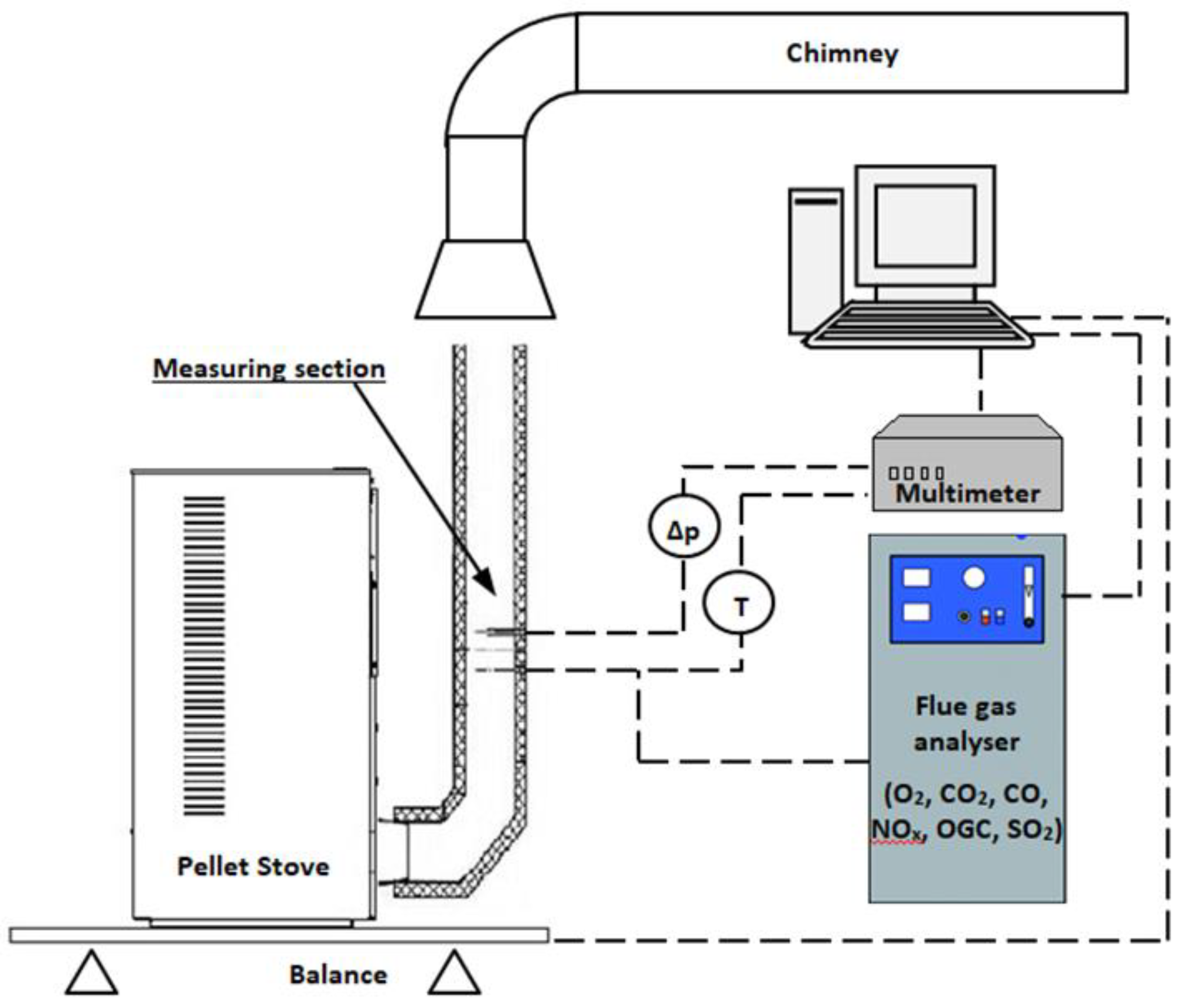
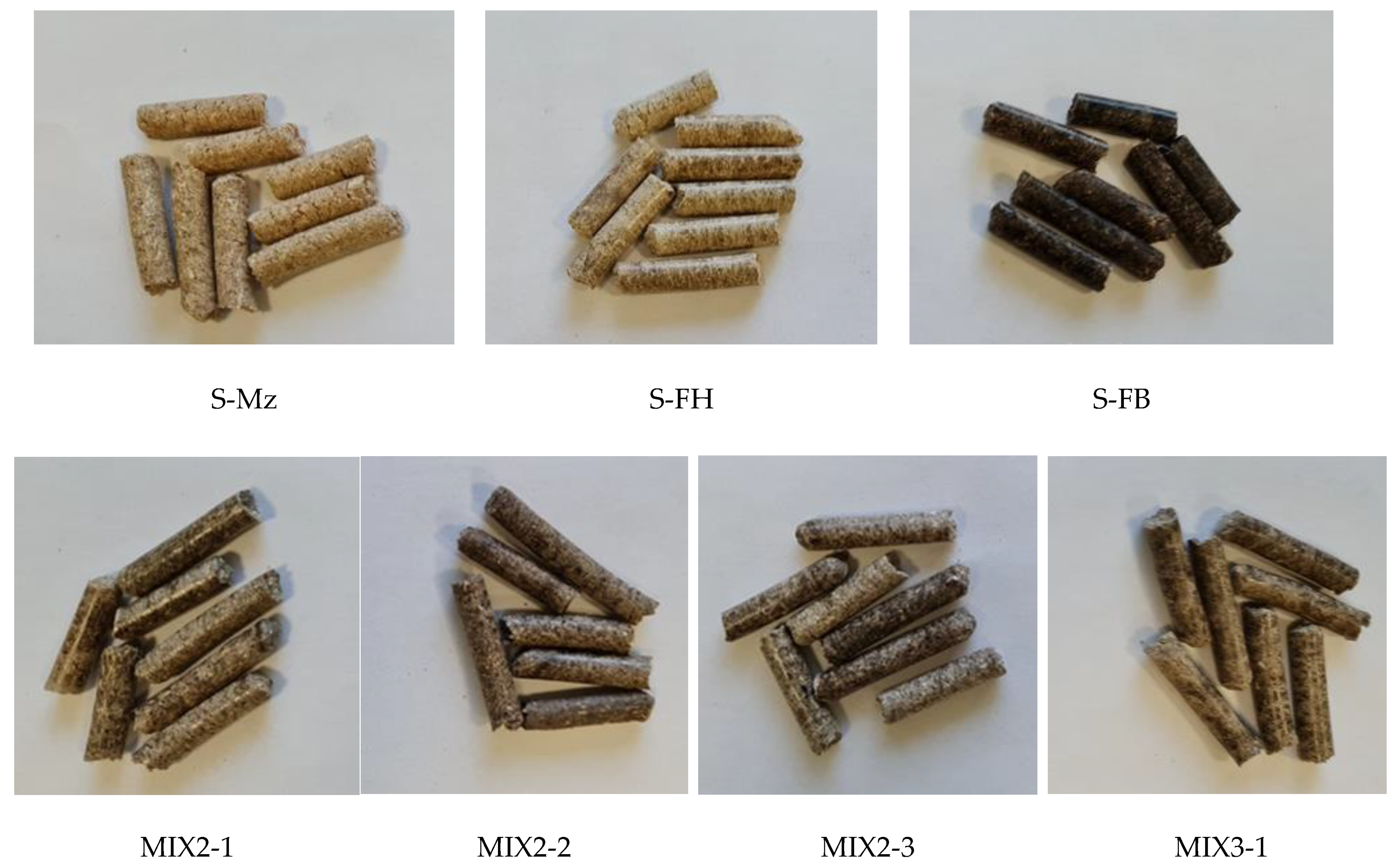
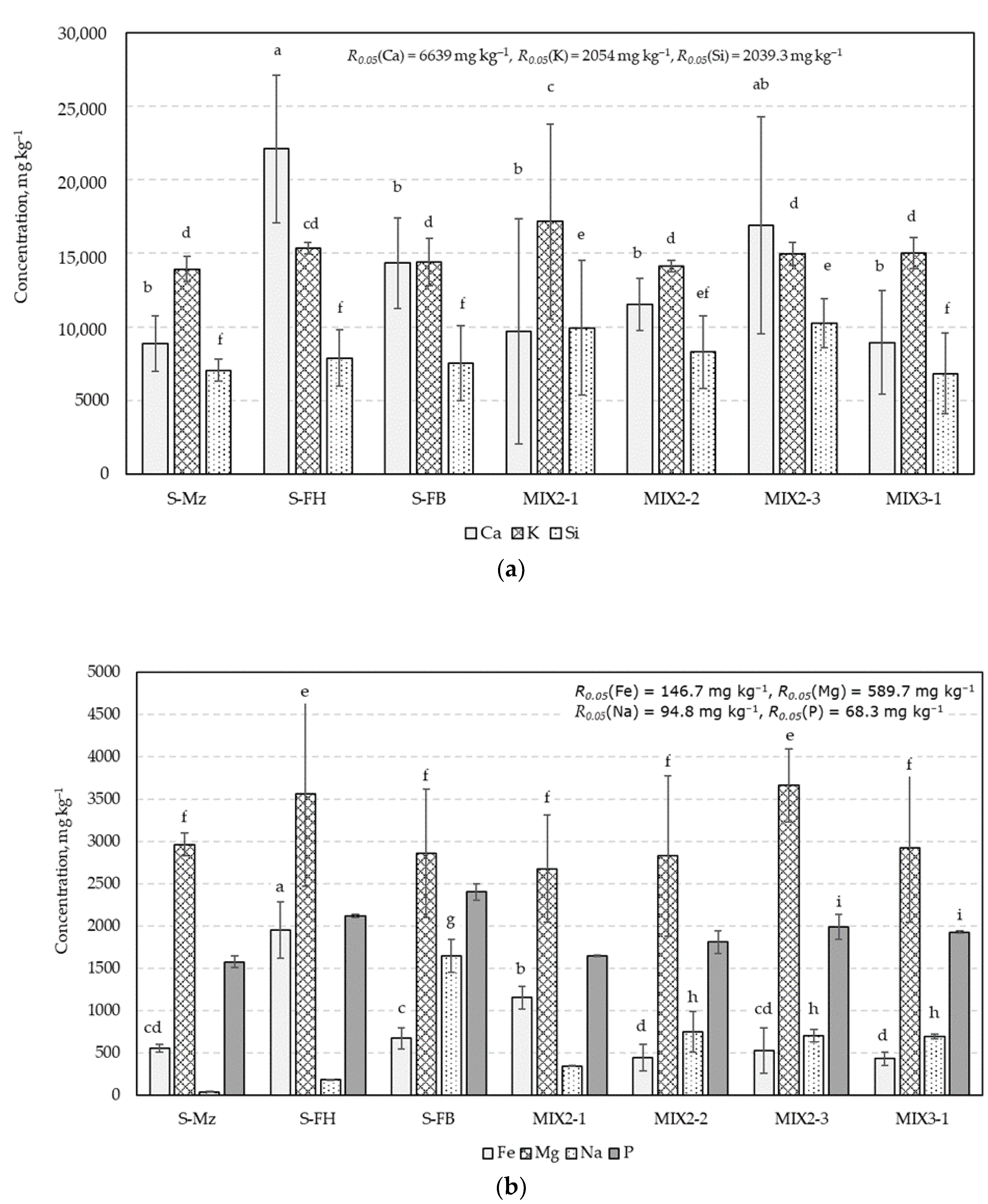
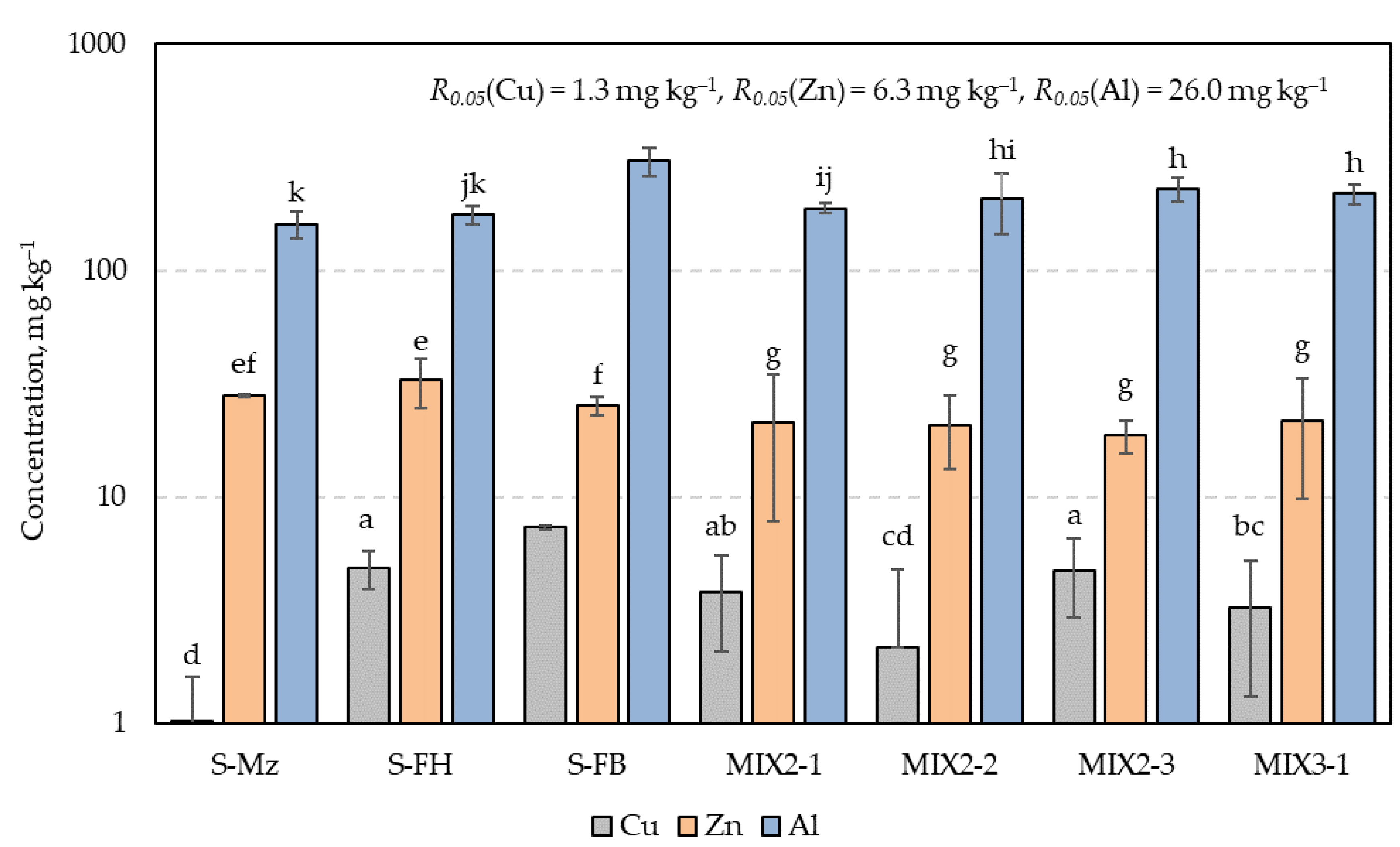

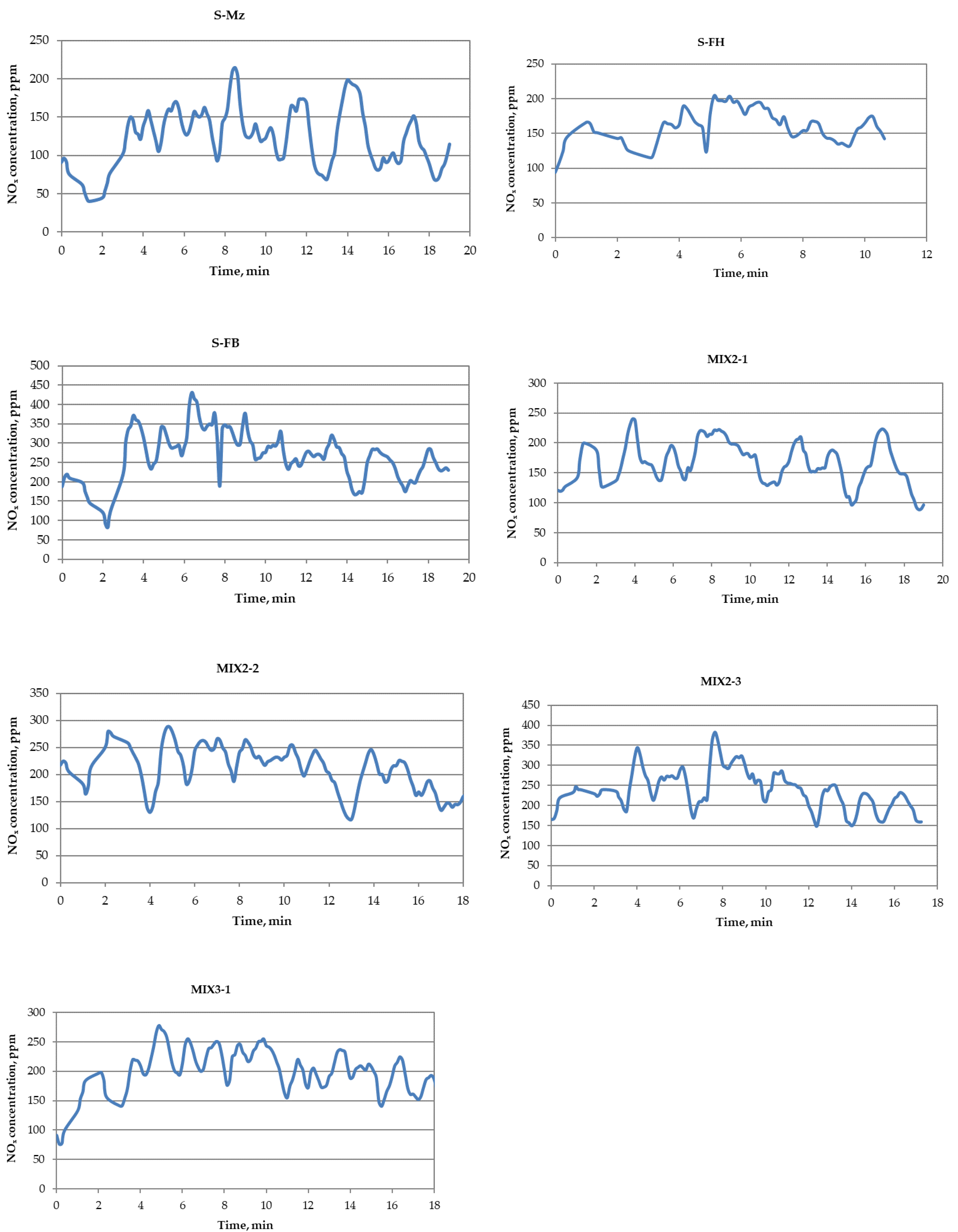
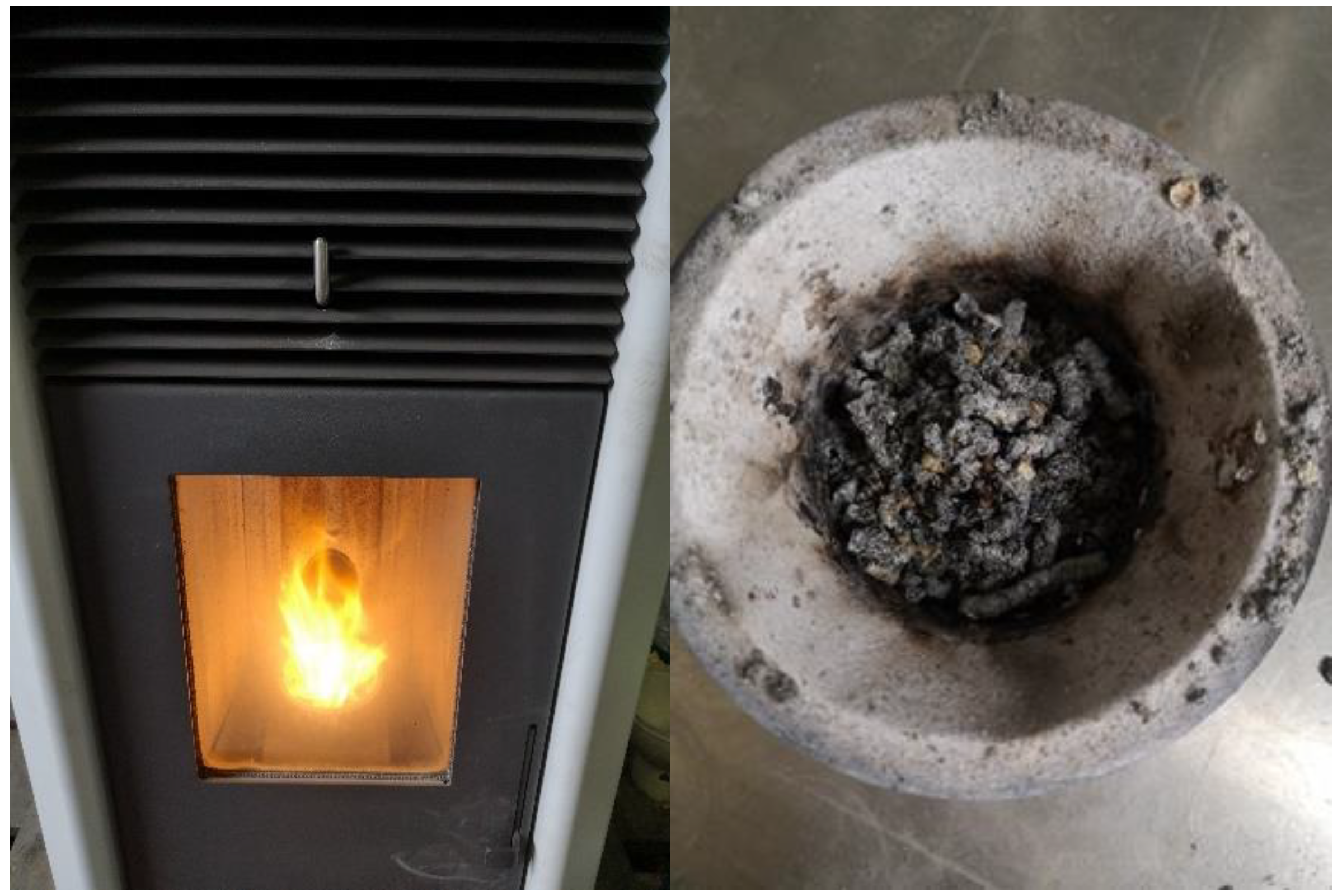
| Experimental Plots | Plants in Experimental Plots | Code of the Biomass |
|---|---|---|
| 1 | Maize (mono) | S-Mz |
| 2 | Fibrous hemp (mono) | S-FH |
| 3 | Faba bean (mono) | S-FB |
| 4 | Maize and fibrous hemp (binary) | MIX2-1 |
| 5 | Maize and faba bean (binary) | MIX2-2 |
| 6 | Fibrous hemp and faba bean (binary) | MIX2-3 |
| 7 | Maize, fibrous hemp, and faba bean (trinomial) | MIX3-1 |
| Parameter | S-Mz | S-FH | S-FB | MIX2-1 | MIX2-2 | MIX2-3 | MIX3-1 |
|---|---|---|---|---|---|---|---|
| Length, mm | 21.5 ± 3.15 | 23.4 ± 2.39 | 20.6 ± 1.69 | 17.6 ± 3.14 | 18.0 ± 5.30 | 23.3 ± 2.98 | 26.6 ± 1.42 |
| Diameter, mm | 6.3 ± 0.07 | 6.2 ± 0.04 | 6.0 ± 0.05 | 6.2 ± 0.06 | 6.0 ± 0.33 | 6.2 ± 0.06 | 6.1 ± 0.08 |
| Density, kg m−3 | 1077.67 ± 90.73 | 1249.78 ± 80.08 | 1210.04 ± 109.72 | 1164.78 ± 159.60 | 1160.21 ± 39.95 | 1211.54 ± 77.51 | 1238.20 ± 104.57 |
| Humidity, % | 12.18 ± 0.24 | 16.63 ± 0.03 | 5.52 ± 0.04 | 8.33 ± 0.03 | 6.66 ± 0.07 | 5.43 ± 0.06 | 6.28 ± 0.04 |
| Ash content, % | 5.75 ± 0.07 | 8.57 ± 0.14 | 8.02 ± 0.07 | 6.87 ± 0.10 | 6.03 ± 0.14 | 7.12 ± 0.18 | 5.98 ± 0.10 |
| LCV, MJ kg−1 | 16.99 ± 0.34 | 16.73 ± 1.11 | 16.72 ± 0.18 | 16.87 ± 0.58 | 16.95 ± 0.41 | 16.81 ± 0.04 | 16.79 ± 0.76 |
| C, % | 46.00 ± 0.14 | 46.55 ± 0.17 | 45.18 ± 0.34 | 46.63 ± 0.06 | 45.65 ± 0.15 | 45.73 ± 0.05 | 46.57 ± 0.06 |
| O, % | 41.53 | 38.51 | 38.07 | 39.25 | 40.82 | 39.34 | 39.90 |
| H, % | 5.51 ± 0.05 | 4.88 ± 0.01 | 5.67 ± 0.05 | 5.61 ± 0.05 | 5.65 ± 0.06 | 5.68 ± 0.04 | 5.68 ± 0.18 |
| N, % | 0.93 ± 0.01 | 1.17 ± 0.05 | 2.67 ± 0.25 | 1.34 ± 0.09 | 1.52 ± 0.02 | 1.93 ± 0.01 | 1.43 ± 0.12 |
| S, % | 0.08 ± 0.01 | 0.13 ± 0.01 | 0.12 ± 0.01 | 0.08 ± 0.01 | 0.10 ± 0.01 | 0.09 ± 0.01 | 0.10 ± 0.01 |
| Cl, % | 0.20 ± 0.01 | 0.19 ± 0.02 | 0.27 ± 0.03 | 0.22 ± 0.03 | 0.24 ± 0.01 | 0.11 ± 0.01 | 0.34 ± 0.04 |
| SST, °C | 948 ± 0.82 | 798 ± 1.42 | 810 ± 2.00 | 822 ± 0.34 | 923 ± 0.77 | 723 ± 0.20 | 1042 ± 0.14 |
| DT, °C | 1004 ± 0.28 | 1461 ± 0.29 | >1550 | 1296 ± 0.65 | 1107 ± 0.13 | 1463 ± 0.01 | 1148 ± 0.74 |
| HT, °C | 1092 ± 0.19 | 1504 ± 0.38 | >1550 | 1394 ± 0.20 | 1169 ± 0.36 | 1474 ± 0.26 | 1177 ± 0.36 |
| FT, °C | 1145 ± 0.62 | >1550 | >1550 | 1423 ± 0.10 | 1201 ± 0.12 | 1484 ± 0.19 | 1206 ± 0.70 |
| Parameter | Class A | Class B |
|---|---|---|
| Length (L), mm and diameter, mm | 3.15 ≤ L ≤ 40 (from D06 to D10), 3.15 ≤ L ≤ 50 (from D12 to D25) | |
| Moisture, % | ≤12 | ≤15 |
| Ash content, % | ≤6 | ≤10 |
| Net calorific value (Q), MJ kg−1 or kWhkg−1 | Q14.5 ≥ 14.5 or Q4.0 ≥ 4.0 | |
| Bulk density, MJ kg−1 | ≥600 | ≥550 |
| N, % | ≤1.5 | ≤2.0 |
| S, % | ≤0.20 | ≤0.30 |
| Cl, % | ≤0.10 | ≤0.40 |
| Cd, mg kg −1 | ≤0.5 | |
| Cu, mg kg −1 | ≤20 | |
| Pb, mg kg −1 | ≤10 | |
| Zn | ≤100 | |
| CO2 | CO | NOx | CxHy | |
|---|---|---|---|---|
| Unit | % | ppm | ppm | ppm |
| S-Mz | 3.5 | 786 | 124 | 42 |
| S-FH | 3.7 | 1609 | 160 | 144 |
| S-FB | 3.9 | 1778 | 270 | 111 |
| MIX2-1 | 4.3 | 572 | 168 | 29 |
| MIX2-2 | 4.3 | 1052 | 210 | 40 |
| MIX2-3 | 4.1 | 1406 | 238 | 74 |
| MIX3-1 | 4.1 | 815 | 194 | 34 |
| Wood pellets | 5.6 | 90 | 43 | 9 |
| Type of Pellets | Boiler Type | Combustion Conditions | Emissions | Source of Literature |
|---|---|---|---|---|
| Sunflower husk pellets Pine pellets | 10 kW domestic biomass boiler | The temperature distribution inside the combustion chamber (300–850 °C) | CO2—9.82% CO—704 ppm NO—344 ppm NO2—20.7 ppm CO2—9.87% CO—665 ppm NO—640 ppm NO2—30 ppm | [50] |
| Wheat straw pellets Rye straw pellets Birch sawdust pellets | 10 kW nominal thermal power and 80% efficiency grate boiler | Air is supplied by a fan at a constant blowing speed of 1 m s−1. The air supply channel was about m3 h−1 | CO2—0.76–7.71% CO2—0.6–6.88% CO2—2.81–7.66%. | [51] |
| Rape straw pellets | 25 kW boiler. Fuel is automatically supplied to the furnace installed in the boiler | The fuel mass flow was 6.15 kg h−1 for wood pellets and 7.63 kg h−1 for rape straw pellets. The exhaust gas temperature was 138 °C and 134 °C, respectively. | CO2—3.15% NOx—119.2 ppm CH4—579.6 ppm | [3] |
| Wheat straw pellets Spruce pellets | 2 kW power experimental device | A propane flame flow (1.2 kJ s−1) is supplied to the upper part of the biomass layer. Underneath the layer of biomass pellets, primary air is supplied with an average velocity of 0.57 g s−1. Secondary swirl air with an average air supply speed of 0.6 g s−1 and a speed of S < 0.6 is supplied at the bottom of the burner | CO2—11.94% CO—250 ppm NOx—250.7 ppm CO2—13.21% CO—121 ppm NOx—67.2 ppm | [46] |
| Faba bean waste pellets | 5 kW solid fuel boiler | Burning time of each sample—10–12 min. The oven maintains the smoke temperature at 200 ± 5 °C. The thrust in the measuring section is maintained at 13 ± 1 Pa. | CO2—4.1–5.0% CO—1072–2785 ppm NOx—133–266 ppm | [52] |
| Faba bean waste and potato peel pellets | 5 kW solid fuel boiler | Burning time of each sample—10–12 min. The oven maintains the smoke temperature at 200 ± 5 °C. The thrust in the measuring section is maintained at 13 ± 1 Pa. | CO2—3.41–4.00% CO—1103–3163 ppm NOx—198–229 ppm CxHy—67–211 ppm | [53] |
Disclaimer/Publisher’s Note: The statements, opinions and data contained in all publications are solely those of the individual author(s) and contributor(s) and not of MDPI and/or the editor(s). MDPI and/or the editor(s) disclaim responsibility for any injury to people or property resulting from any ideas, methods, instructions or products referred to in the content. |
© 2023 by the authors. Licensee MDPI, Basel, Switzerland. This article is an open access article distributed under the terms and conditions of the Creative Commons Attribution (CC BY) license (https://creativecommons.org/licenses/by/4.0/).
Share and Cite
Petlickaitė, R.; Jasinskas, A.; Domeika, R.; Pedišius, N.; Lemanas, E.; Praspaliauskas, M.; Kukharets, S. Evaluation of the Processing of Multi-Crop Plants into Pelletized Biofuel and Its Use for Energy Conversion. Processes 2023, 11, 421. https://doi.org/10.3390/pr11020421
Petlickaitė R, Jasinskas A, Domeika R, Pedišius N, Lemanas E, Praspaliauskas M, Kukharets S. Evaluation of the Processing of Multi-Crop Plants into Pelletized Biofuel and Its Use for Energy Conversion. Processes. 2023; 11(2):421. https://doi.org/10.3390/pr11020421
Chicago/Turabian StylePetlickaitė, Rita, Algirdas Jasinskas, Rolandas Domeika, Nerijus Pedišius, Egidijus Lemanas, Marius Praspaliauskas, and Savelii Kukharets. 2023. "Evaluation of the Processing of Multi-Crop Plants into Pelletized Biofuel and Its Use for Energy Conversion" Processes 11, no. 2: 421. https://doi.org/10.3390/pr11020421
APA StylePetlickaitė, R., Jasinskas, A., Domeika, R., Pedišius, N., Lemanas, E., Praspaliauskas, M., & Kukharets, S. (2023). Evaluation of the Processing of Multi-Crop Plants into Pelletized Biofuel and Its Use for Energy Conversion. Processes, 11(2), 421. https://doi.org/10.3390/pr11020421









